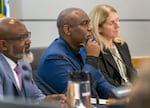After about 24 hours of continuous negotiations, bargaining teams from Portland Public Schools and the Portland Association of Teachers reportedly reached a tentative agreement that would end the ongoing teachers strike. That’s what the union says. Union representatives also claimed the board unanimously voted to reject the recommended deal.
“This crisis of their own making unnecessarily prolongs the strike,” they wrote to their members in an email Monday morning, “and demonstrates the inability of district leadership to govern Oregon’s largest school district.”
However, board Chair Gary Hollands said there was no tentative agreement and that the board did not reject the whole proposal. The biggest hang-up is on class size limits.
District officials said the two sides have agreed on a 13.8% cumulative cost-of-living increase over three years. The district initially proposed just shy of 11%, while the union originally fought for about twice that.
The district says the two sides have agreed on 17 articles since Thursday, including planning time, special education and mental health supports. They said only three articles and two appendices have yet to be tentatively agreed to.

FILE - Portland Public Schools Board of Education Chair Gary Hollands, center, listens to comments during a board meeting at the PPS district office in Portland, Nov. 7, 2023.
Kristyna Wentz-Graff / OPB
Hollands told reporters during a press conference Monday morning that the bargaining team brought a conceptual proposal to the three board members at the bargaining table for their consideration. The board disagreed on how the suggested class size committees would operate and what parental involvement would look like.
“Now, while there were many things in the proposal that we could agree on, there [were] also some fundamental issues, specifically around parents having the ability to make educational decisions about other people’s children, that we cannot agree on,” he said. “This is what needs to be worked out. And we were expecting to work through those concerns today in order to get our kids back to school on the 27th [of November].”
Board member Julia Brim-Edwards told reporters the concern is having the committees operate at the classroom level where any parents involved could possibly gain access to private student information.
She gave an example: If a student moved into a neighborhood in November, and the class they were moving into was a third-grade class at the maximum size, there would be a process to decide whether the student would be allowed to join that class.
The new class size committees in question would be looking at various remedies. She said those could include adding an educational assistant or teacher or adding the child to the class anyway. She said the board members’ concerns were about a parent possibly accessing sensitive information and deciding whether they want them in the class.
“We’re just not comfortable with parents making decisions for other people’s children,” Brim-Edwards said, adding that board members believe that responsibility falls to the principal. She said they support a committee composed of the principal, another administrator and two teachers.
“Speaking as a parent, there are things about my children that I think are very private to our family and to the individual student,” Brim-Edwards said.
“We feel definitely there’s a role for parents in the broader school-level decision-making around class sizes. We know parents care about that. And we’re all parents. We want to have lower class sizes,” she added. “But we also think that people making the decisions should be the educators, principal, or school administrators.”
According to a PAT proposal last Friday, the class size committees would include two parents or guardians as voting members. The principal and PAT building representative must agree on the parents or select one each. But the section also has a workaround if parents aren’t included, saying, “Lack of parent/guardian involvement will not preclude the committee from developing recommendations.”
PAT leaders said they will remain on strike until the board accepts the deal the two bargaining teams agreed upon.

FILE - Portland Association of Teachers members and supporters hold signs as they attend a board meeting at the Portland Public Schools district office in Portland, Nov. 7, 2023.
Kristyna Wentz-Graff / OPB
Once a tentative agreement is reached, the board votes to approve it, then union members must ratify it. Bargaining teams also need to finalize a “return to work” agreement to determine the logistics of schools resuming.
“We feel like we’re very, very close,” Brim-Edwards said when asked if they expect to reach a deal this week. “And we feel like it’s a good deal … for teachers, parents and students, and we desperately want kids back in their classroom. We know they want to get back in their classrooms.”
The earliest students will return is Monday, Nov. 27.
Kristian Foden-Vencil contributed to this story.
